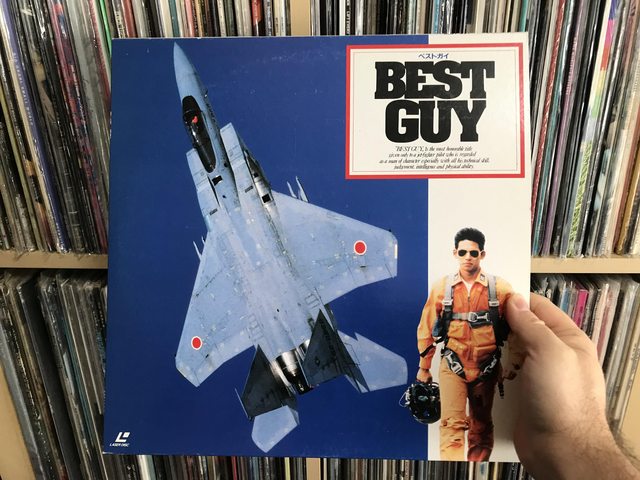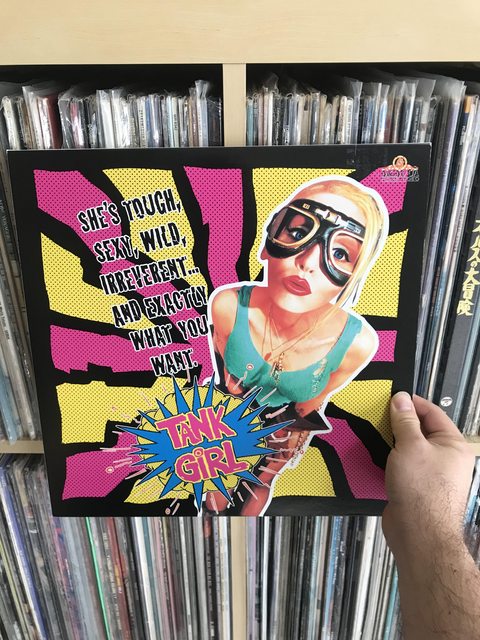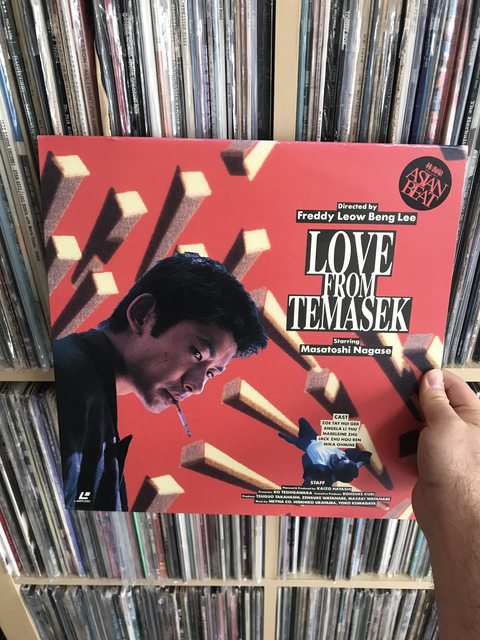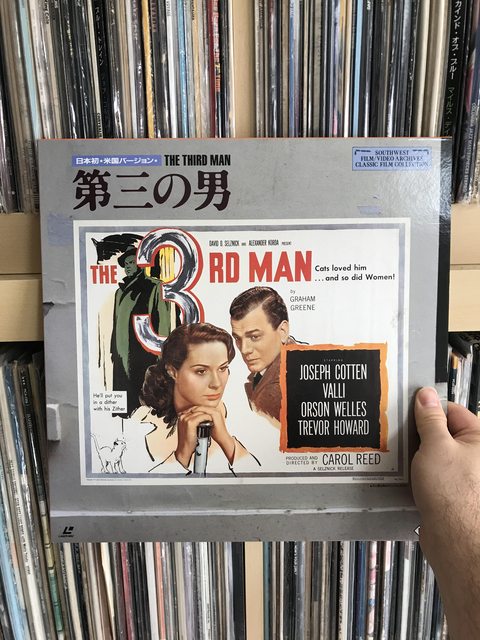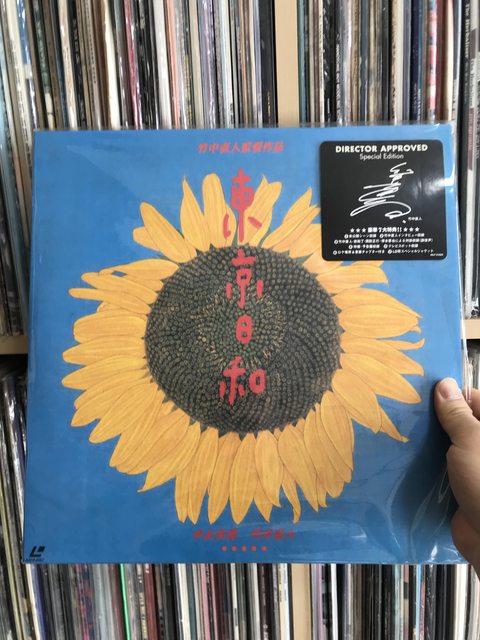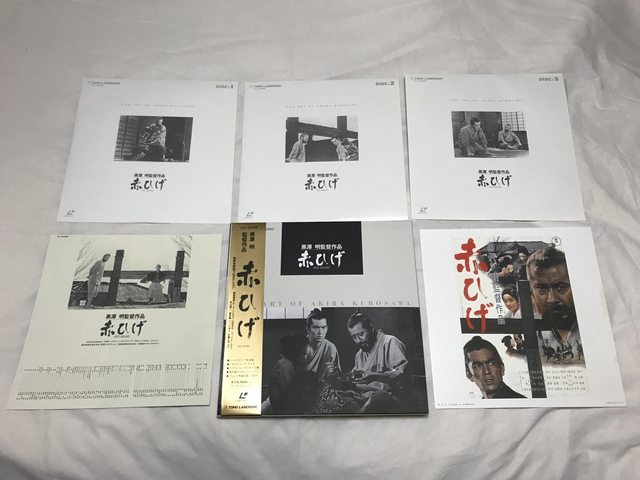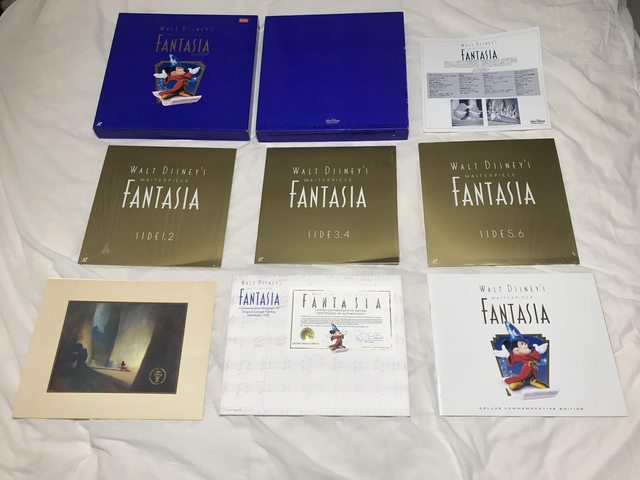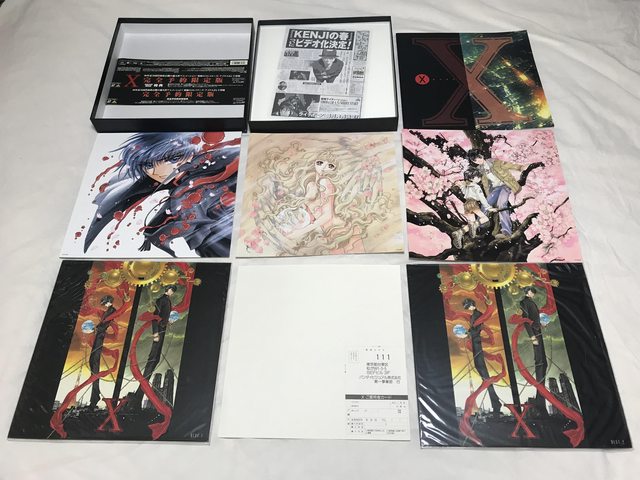REWIND FEATURE: Getting into Laserdiscs in 2023
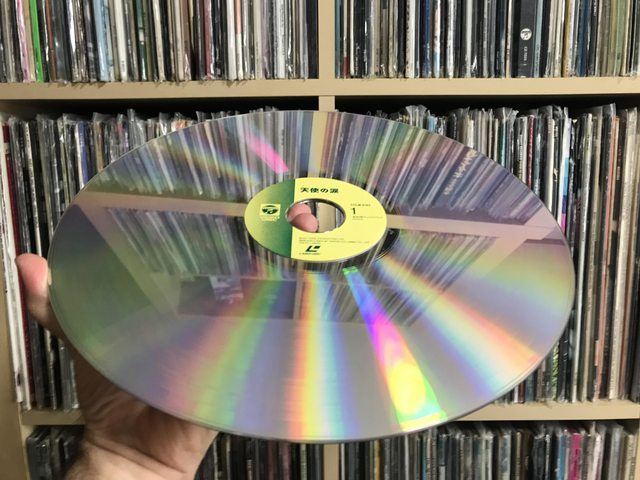
On the very last day of 2022, I made a considerable update to my home theater. I bought a Laserdisc player. Yes, the optical disc home video format that pre-dates our website here is finally part of my setup, and was interestingly never part of my life even growing up.
My father was always a tech-head, loving getting into new technology before others. We have home videos of our childhood because of his early adoption to 8mm Video and are still viewable as we’ve had them transferred digitally. In comparison, I have a number of friends of the same age group that do not have video footage of their childhood, relegated only to photographs. I didn’t have any friends that had home computers back at the time yet we had both Apple and DOS hardware to play with. Some of my father’s decisions were not exactly great, as he bought reel-to-reel recorders before I was born, and he was convinced that Betamax would win the videotape format war and was not sold on the idea of CDs until the 1990s. He was one of the first people I knew that had a DVD player via DVD-ROM, and he tinkered with the home theater setup for years on end with lots of gear that I didn’t quite understand but was enamored with.
Yet we never had a Laserdisc player. My dad was not a movie collector, and instead was more of a television fan, especially science fiction. The Betamax (and eventually VHS) tapes were blanks that he recorded "Star Trek", "The Outer Limits", "The Twilight Zone", as well as shows for the kids with Disney cartoons, "The Muppet Show", "Dragon Ball" and more. We didn’t watch a whole lot of movies, and for him, buying a video cassette seemed like a waste of money when there was already a great deal of free content on broadcast television, which we often taped for later viewing, including movies. As for Laserdisc, I had never even heard of the term or seen the format until much later in my life as a teen.
It’s interesting to think that as I spent quite a bit of my childhood in Japan, a country where the Laserdisc format at its height was in 10% of Japanese households, I didn’t have any relatives that had a player or a disc. If someone had one, I didn’t know about it.
Looking at the history and specs of the format, which pre-dated my existence, it’s easy to see why my dad didn’t get into it. LDs were not a recordable medium. (Though there were recordable LDs, these were for the professional workspace and not for home media.) With my dad wanting to marathon Star Trek episodes, a Betamax tape or VHS tape could record 5 hours or 8 hours respectively on EP mode. Size was another issue. He got rid of reel-to-reel early on, as moving every few years for his job would be troublesome. We did have some vinyl records, but they are incredibly light in comparison to LDs even if their sizes were the same 12 inches in diameter. A 12” Laserdisc weighed 200 grams in comparison an average 12” vinyl record weighing about 140 grams, and are slightly thicker. True that tapes would also take up space as well, but they were lighter, easier to take care of and not an issue for kids to handle. Fingerprints on a video cassette’s plastic case would not be an issue for playback, but have a child handle an LD and it’s bound to get scratches and fingerprints all over it.
Fast-forward to the late 90s and early 2000s when I was getting into films, filmmaking much deeper, due to taking video productions classes in high school and being exposed to international cinema such as Kurosawa and Kieslowski to name a few. In addition, the introduction of DVDs made a giant step forward for quality. The digital picture was sharper, original theatrical widescreen presentations, digital audio including 5.1 surround, and most importantly, the inclusion of extras. One of my very first DVDs I had to have in my collection was “Seven Samurai”, my all time favorite film. Available on a single disc, removable subtitles, and a feature length commentary? The technology blew me away as my first encounter with the film was on two VHS tapes that had burned-in bright ugly yellow subtitles. But when looking at the information stating the commentary was originally from 1988, this confused me. How did people hear this commentary back in 1988? It was from there that I learned that The Criterion Collection, which issued “Seven Samurai” on DVD in the United States, had previously released their titles on the Laserdisc format, and was the first company ever to include an audio commentary track, which was on their Laserdisc of the original 1933 “King Kong”.
While accumulating a sizeable movie collection on DVD and Blu-ray over the years, as well as a large music collection on vinyl and CD, I sometimes found Laserdiscs mixed in with vinyl records at second hand shops. I sometimes purchased the Laserdiscs because of their unique looking artwork, though I didn't particularly think about purchasing a player, as the titles I wanted were usually already on DVD or Blu-ray.
At the end of 2022, while shopping around a second hand store in Tokyo, I came across an interesting looking Laserdisc with the title “Best Guy”, a 1990 Japanese film. With a fighter pilot dressed in orange and sporting dark sunglasses and a fighter jet in the sky, it looked like a “Top Gun” clone and starred popular Japanese actor Yuji Oda in the lead. I wasn’t planning on buying it, but I forgot to put it back in the bin and I ended up purchasing it alongside other items. At ¥100, it was not at all a loss. I admit I’ve never seen “Top Gun” in full, and have not watched “Top Gun: Maverick” either, so even if I watched “Best Guy”, I couldn’t exactly compare it. But for me, discovering a film I am unfamiliar with is always a true pleasure. The film had a number of well known Japanese actors, and watching the trailer on YouTube showed that it seemed to have a fair budget with real flying sequences. I checked to see if the film was available on DVD and it was released in Japan in 2004, though it was never re-issued and the disc goes for a premium price at this point in time. There were also no options for streaming the film.
But looking into the disc, the artwork, and some information I saw online, I was getting more and more intrigued by this somewhat cheesy looking feature, and so I thought I should go ahead and look into finally buying a Laserdisc player. I knew that I shouldn’t buy the first one I would come across, though I was unfamiliar with what kind of things I should be looking for.
I knew of the two main types of discs: CLV and CAV, with CAV discs being the higher quality ones though having a shorter runtime per side. Learning that every player was compatible with both types of discs, I didn’t have to worry about compatibility. Like DVDs, LDs also had NTSC and PAL formats, and I wasn’t particularly looking for a multi-format player so I would look at only local NTSC players. I learned that some early players didn’t have a digital audio output so I made sure to check if a player had coaxial or optical outputs. There were some players that had a function to play both sides of a double sided disc without having to flip the disc over, so that was also a function to look out for. Some LDs had Dolby Digital 5.1 or DTS 5.1 tracks available like on DVD, so looking for those symbols on covers were a must (but more on playback later). Most importantly for buying a player was making sure that one worked, as finding a player from decades back that still worked without issue might be troublesome.
I thought that buying a late model, from the late 1990s would be a good choice, and I found information that the Pioneer DLV-919 was an excellent choice, as it played both DVDs and LDs in one machine, could play both sides of an LD without flipping, had digital audio outputs with coaxial and optical, and had component video output. I did not particularly need one with DVD capability, but it was a sure sign that it was made in the late-90s and was a more "recent" model. Upon research I found that component video was something I should have not been looking for. This was only for the DVD video output, and was not used for Laserdisc video output, which was relegated to only the S-Video or composite output with the standard yellow. I did find some DLV-919s in store in working conditions, but they were much too expensive.
I came across the Pioneer CLD-R5 at a second hand store for an affordable price with a guarantee of functionality and a three month warranty. As it had the option to play back both sides without flipping the disc, had digital audio output, and was at a good price, it went to the top of my list of players to possibly get. It didn’t have DVD playback, and had optical though no coaxial digital output, which were not dealbreakers for me. After looking around at other nearby shops and online options, I went back to the store a few days later on December 31st, 2022 to pick up the player, which by the way did not come with a box, manual, or remote and only had the power cord. The total was about ¥17,000. I found the instruction manual online from Pioneer’s website, and didn’t think I needed a remote (but more on that later).
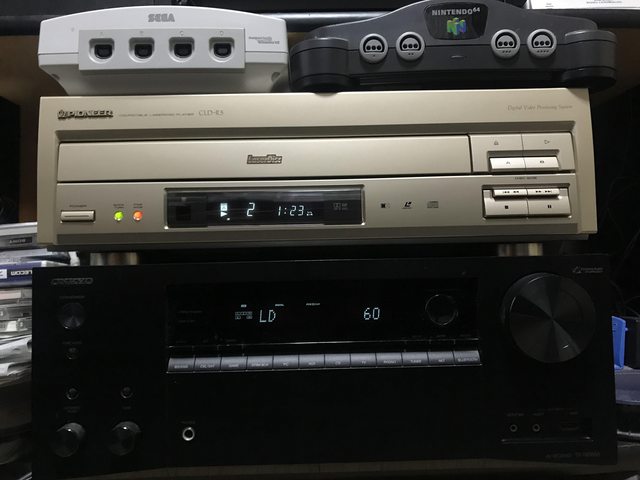
Setting up the six kilogram machine wasn’t too difficult, by hooking up analog video and audio as well as the optical audio cable to the receive. As my Onkyo receiver does not upscale standard definition, it would display the signal on my 4K Panasonic television as standard 4:3 NTSC, via composite video. On the front display had the standard functions such as play, eject, Side A, Side B, etc. as well as “Quick Turn” which would automatically switch sides from A to B on playback and also “Fine Wide” which looks to sharpen the image for playback for widescreen displays. Of course, the first disc to be watched was the aforementioned “Best Guy”. I inserted the disc, pressed play and was ready to experience Laserdisc at home for the first time as the disc spun and whirred loudly.
So one issue that came up immediately was that the 1.85:1 widescreen film would be presented with full windowboxing, as 99% of Laserdiscs were produced for the standard 4:3 television sets that were the norm until the 2000s. So it was either watch the film in a windowboxed form with thick black bars surrounding the entire image, or to use the zoom function on the television, which meant a fuller picture but less definition and more blurriness. I opted to zoom, but here came the slightly troublesome issue with my Panasonic 4K TV that I had to deal with a year ago when I first purchased it.
Since I have a multitude of game consoles from past and present hooked up to the television, “game mode” is always turned on, as I immediately noticed critical input lag when playing games. But an issue came up when I tried to play my older consoles such as the Super Famicom and Nintendo 64 on the 4K TV. The aspect ratio could be changed when “game mode” was off, but when it was turned on, the image was stuck at a stretched 16:9 aspect ratio and there was no option to set the image to 4:3. Panasonic’s CS informed me that it was impossible to change aspect ratios when “game mode” was on, so that led me to buy an external upscaling device that would correctly display the original aspect ratio, and that was the “Up Empire 2”, which had composite and S-Video inputs, an HDMI output, and a thankful option to output the signal in 4:3 or 16:9. With this little device, I was able to display 4:3 games in the correct 4:3 while having “game mode” turned on. I didn’t have this issue with my Toshiba HD TV from a few years back, so it was not an issue I was expecting. Now getting back to the Laserdisc playback, if I wanted to play a Laserdisc with the zoom function on, this meant going into the TV settings, turning “game mode” off, then going to aspect ratio and setting it to “zoom”. All said and done, the disc was now properly playing without heavy black bars.
“Best Guy” is the story of ace fighter pilot Hideo Kajitani (played by Yuji Oda), nicknamed “Goku”, who aims to become the “Best Guy”, the highest title to be achieved by his squadron. But he has had mishaps in the past, a rebellious attitude, as well as dealing with the death of his brother who was also a fighter pilot, while also juggling his love life with Miyuki (played by Naomi Zaizen), a music video director. With full cooperation by the Japan Air Self Defense Force for filming, “Best Guy” had its bad boy yet likable heartthrob idol in the lead, plus exciting aerial sequences, but there are a lot of things it falls flat on. The story is fairly uninspired, consequences do not feel strong, and the dramatic aspect does not spark much interest either. There are some comical moments (such as prolific actor Naoto Takenaka spewing an F-bomb in English in a small role) but these also feel awkward more than funny. Not at all a terrible movie as it has its strengths in the action, but not a memorable one. For the music, it featured songs by Canadian singer Sheree including the theme song, as well as playing herself in the film, as the singer that the character of Miyuki was working with, and has a few dialogue scenes. It was a target to have a more international flavor, but it didn’t do much for her music career or for the film’s box office. With a ¥600 million budget, it only made ¥230 million and was forgotten about fairly quickly.
So, “Best Guy” was not the most memorable experience as a movie, but it was fascinating to see the format in action. The picture may be in standard definition like VHS, but the defects of magnetic tape such as tracking errors and static were absent, and the only issues came with the zoomed in image. Being so used to HD and 4K visuals for quite some time now, it was a different sort of eye-opener with something coming from an analog format. (Yes, Laserdiscs may be optical discs and have digital sound, but it stores video in an analog format.) Colors were bland, detail was blurry, but it was still a fascinating experience to be had and I was curious to see more of what I had in my library of about forty discs, especially to compare titles which I also had on DVD or Blu-ray. As for the sound, “Best Guy” had a 2.0 surround track, and it was quite good. I was impressed with the use of left and right separation and it was well balanced. The only thing I noticed being disappointing was that there was a noticeable buzz to be heard at a low volume. It was after the fact that I realized I had watched the film with the analog 2.0 audio track. Laserdiscs have four audio channels for NTSC discs: digital left and right tracks and analog left and right tracks. This is where I learned that I needed a remote control, as there was no way to change audio tracks on the player without one.
I had an old Pioneer DVD remote, but that did nothing while pointed at the LD player. I had to get an LD specific one. I took a gamble by buying a vintage supposedly working Pioneer LD remote control off an Amazon seller for a very low ¥500. It arrived the next morning and it worked like a charm. It was from here I could change audio tracks from playing digital stereo, analog stereo, to only playing one of the left or right audio channels, as well as other basic functions. Replaying some scenes from the “Best Guy” disc and switching between digital and analog audio, the difference was clear. The slight buzzing was gone and had a clearer and fuller sound overall.
Having the digital audio option accessible now, I was excited to try some music LDs, and one that I bought at the same time as the player was “Off Course: 1982.6.30 Concert in Budokan”. I’ve reviewed the Blu-ray release of the concert film last year, and while that is obviously the best version on the market as of now, I thought it would be an interesting experience to see it and hear it in the Laserdisc format. But on playback something was wrong. There was no sound coming from the speakers. After messing around a bit, the issue was that the disc had no digital audio. It was an analog-only Laserdisc, with only analog stereo audio included. My receiver was defaulting to the optical digital input and the LD remote buttons wouldn’t let me switch to the analog tracks for playback. Going into the receiver’s setup and disabling the optical digital signal did the trick and the audio played fine. So comparing the uncompressed LPCM stereo audio from the Blu-ray which was newly mixed in 2022 with the analog stereo audio from the Laserdisc showed quite a lot of difference in depth and clarity, but the LD audio was quite good on its own, with good balance between music and vocals, though the hum and buzzing from the analog signal is noticeable in quieter moments. This was a Laserdisc that was originally pressed in 1983 - exactly forty years ago and thankfully it plays wonderfully. It’s said that optical discs have an average lifespan of fifty years. There have been issues of CDs and even DVDs showing signs of disc rot, with discs becoming completely unplayable. Of course disc technology has come a long way, so Blu-rays and UHDs are much more durable and would last much longer than discs manufactured in the 1980s, but collector’s must take note that these things are not fully future proof.
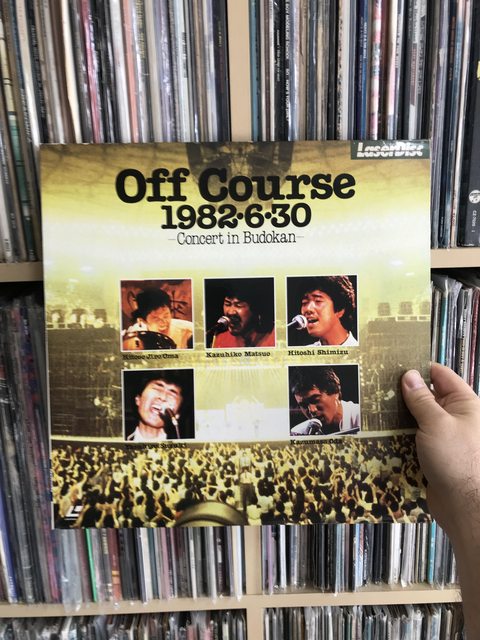
With audio, I was able to test out the Dolby Surround discs, which were basically digital or analog 2.0 tracks that were mixed specifically for playback using Dolby Pro-Logic, to spread the two channel audio to four channels (left, right, center, rear). I wanted to experience 5.1 surround with the Laserdisc format, and since I’ve had Dolby Digital 5.1 and DTS 5.1 capabilities since the early 2000s with DVDs, and having a modern receiver capable of everything from phono inputs to Dolby Atmos and DTS:X, I thought I was set. I was wrong.
I had a few discs that had the “Dolby Digital” or alternately “Dolby AC-3” logo which encoded 5.1 audio. Interestingly these were not encoded in the digital audio tracks, but were encoded in the right analog audio track. To play a Laserdisc Dolby Digital track, it wasn’t as simple as plugging a coaxial or digital cable like it was in the DVD days. Instead, one needed a player with a separate AC-3 output, which needed to be connected to an RF demodulator to decode the signal and output it as a 5.1 track, then sent to a receiver, or use a receiver with an RF demodulator built in. With modern receivers, this is something that isn’t available anymore. So for this, I was out of luck. If I do come across an RF demodulator someday and it isn’t that expensive, I may look into it. But with the number of things hooked up to the home theater at the moment and having another box of wires and a power brick just doesn’t seem like a necessity for now.
As for DTS, this seemed to be a much simpler task, as I read that DTS audio is encoded on the digital channels. I had one Laserdisc which had DTS written on the packaging and it was “Tank Girl”. Though this was not a DTS 5.1 track but “DTS Stereo Surround”, which was basically the same as Dolby Surround, which had the digital or analog 2.0 tracks matrixed for surround sound on a receiver to 4 channels. Unfortunately I don’t have any DTS 5.1 Laserdiscs and have not been able to test it out. Maybe in the future when I come across a disc.
One major interest with an older format was looking for titles that have not been ported over to a next generation format. “Love from Temasek” was a disc that I found that did not have a DVD or Blu-ray release. I’d never heard of the film and even though it had a “2” within the title as “Asian Beat 2: Love from Temasek”, it seemed like a good idea to pick it up. “Asian Beat” was a series of five direct to video films all released in 1991, with each having actor Masatoshi Nagase playing the character of Tokio, a young cool Japanese man finding himself in different sorts of troubles in different countries around Asia, with each installment by a different director from differing countries. “Love from Temasek” takes place in Singapore, and the multilingual feature film balances action, drama and comedy fairly well, especially with Nagase and his female co-star Zoe Tay playing a Singaporean reporter. Being direct to video, it is presented in the 1.33:1 aspect ratio on the Laserdisc and looks quite good, with the option of digital or analog mono soundtracks. It also strangely starts with the original trailer at start-up, so there are spoilers to be seen. It seems like an odd choice that the only extra is the trailer for the film itself, and not including the trailers for the other films in the series, or at least the first film, “Asian Beat 1: I Love Nippon”. In addition to the film series not being available on DVD or Blu-ray yet, the films didn’t get a full release on Laserdisc either. “Asian Beat 1: I Love Nippon” (Japan), “Asian Beat 2: Love from Temasek” (Singapore) and “Asian Beat 3: Powder Road” (Thailand) received LDs in Japan, but the final two “Asian Beat 4: Shadow of Nocturne” (Taiwan) and “Asian Beat 5: Autumn Moon” (Hong Kong) were only released on the VHS format. Does this mean I’ll have to invest in a VHS VCR and start collecting yet another old format…? There are still a number of works that have not been ported over to newer home video formats or streaming, and maybe one day they will be. But it’s not only films that are not ported, but also bonus features.
Looking for titles that had extras on Laserdiscs was another thing of interest, and finding extras that were not ported over to DVD or Blu-ray was another search. I came across the Laserdisc of the Toei Animation feature film “Little Prince and the Eight-Headed Dragon”, a 1963 anime based on Japanese mythology and was one that I was not particularly familiar with. There was a theatrical trailer, found on the last chapter after the film ends, as well as an isolated music track. The film is presented in mono, so the left digital and analog tracks are the feature film audio with dialogue, music, and effects fully mixed, while the right digital and analog tracks are the isolated music cues, composed by the legendary Akira Ifukube, who created the legendary Godzilla theme, as well as countless other Toho kaiju film scores, plus working with Akira Kurosawa on the director’s 1949 film “The Quiet Duel”, and composing the iconic music for the Zatoichi film series and the Daimajin film trilogy. The film was released on DVD and Blu-ray in Japan, but neither offered the isolated music track as a bonus feature. Here it was, locked away on the Laserdisc format. Now, it is possible to hear these tracks in isolated form on CD, as the score soundtrack with bonus alternate takes were made available in Japan. The soundtrack is an excellent one, with bombastic adventure cues that are perfect for the action and have some similarities to Ifukube’s monster film cues at times, as well as having beautiful vocal pieces for the emotional scenes. It should also be noted that illustrator Yoichi Kotabe worked on the film as an animator. He worked in both feature film and television as well as in video games throughout the decade, with his work for Nintendo being some of the most notable, with Super Mario, The Legend of Zelda, Pokemon, and more. His character designs for “The Legend of Zelda: Wind Waker” took heavy influence from his work on “Little Prince and the Eight-Headed Dragon”, with Link having similar features to that of the young main character Susano.
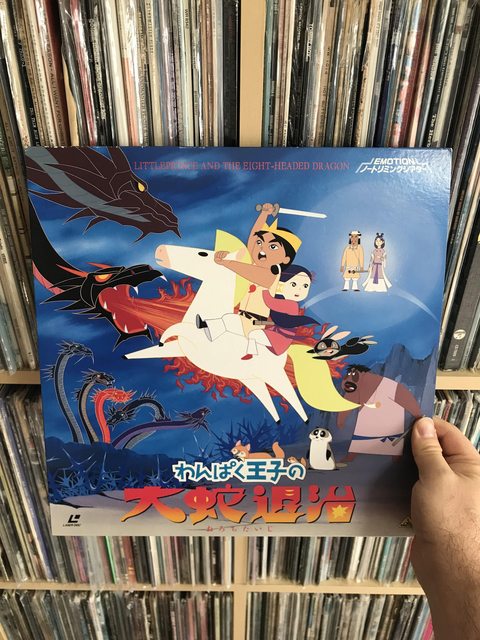
The 1987 film "Innerspace" is one that I already have on Blu-ray, but when I came across the Japanese Laserdisc in a bargain bin, I was intrigued that it said the disc included a "special clip". The DVDs and Blu-rays have a commentary and trailer included, so what was this exclusive on the Japanese LD? A vintage making-of that was not ported over? Unfortunately it is a bit lackluster, and is a compilation of the scenes of Dennis Quaid in the inner body portions, with a visual graphic indicating where in the body he is for the scenes. Another disc I picked up was the 1949 classic "The Third Man" on LD from IVC. Advertised as being the original American version of the film which was never before released in Japan ( I assume only the UK version was available), the transfer came from the Southwest Film/Video Archives, which was founded in 1970 by Dr. G. William Jones, a professor of cinema and video at Southern Methodist University. The disc opens with a 1949 newsreel from Castle Films, followed by a short introduction by G. William Jones himself on "The Third Man". The film plays right after (with a side change in between), then it is followed by a three minute discussion of the film by Jones again, and finally the 1949 animated short "Snow Foolin'". The transfers from the newsreel and cartoon also came from the same archive, which was renamed The G. William Jones Film & Video Collection. Jones passed away on May 11th, 1993 at the age of 62 from brain cancer. As far as I can tell, these video pieces with Jones has never appeared anywhere else, as the Japanese LD reissue by Pioneer in 1996 didn't have them, the US Criterion LDs also lacked them, and have not been ported to DVD or Blu-ray. The G. William Jones archive has a YouTube Channel, which has uploaded a number of rare clips from their archive, though these clips are not available on their channel. I also found the IVC Laserdisc of "His Girl Friday" (1940) from IVC and also had the Southwest Film/Video Archives logo on in. Unfortunately there were no extras on this particular disc.
Knowing that audio commentaries were started on the LD format, I was looking forward to hearing any that I hadn’t before, or were stuck on the format and hadn’t been ported to DVD or Blu-ray yet. I only had one disc that had a commentary track and that was “Tokyo Biyori” from 1997. Directed by and starring the aforementioned Naoto Takenaka, the film was a biopic on photographer and artist Nobuyoshi Araki and his essayist wife Yoko Araki (played by Miho Nakayama) which was nominated for eleven Japanese Academy Awards and won one for Best Score. A very nice gatefold packaging with a sticker on the front saying “Director Approved” like many Criterion discs have, this not only had a commentary track, but also had a teaser, trailer, TV spots, an interview with Takenaka, as well as deleted scenes. I have not seen the film yet, though I am curious to see it as well as hear the commentary which includes Takenaka, the screenwriter Ryo Iwamoto plus special guests Masayuki Suo and Shinya Tsukamoto - two filmmakers that made cameo appearances in the film and have worked with Takenaka on a number of films over the years. Upon research, the film was issued later on DVD and included these extras, though it is using the same non-anamorphic widescreen transfer as the Laserdisc edition. To access the audio channel it was a bit of a hassle as well. I had to disable the optical input, turn on the analog audio input, and scroll to the right analog audio track. Compared to how easy it is to scroll through audio tracks with a single button in most cases for DVDs and Blu-rays, it’s not the most ideal on Laserdisc.
Searching for LDs containing commentaries, I found that Japanese discs rarely if ever included commentaries. And if they were, they were rarely found on non-Japanese films. The issue was with subtitles. If it were a Hollywood feature, it would have the original English audio with burned-in Japanese subtitles for translation. If a secondary English language audio commentary were to be included, there would not be a way to change the subtitles on screen. Now, there were technically ways around this. Closed Captioning was included on the LD format and that would create a text stream within a black box which would be electronically placed over existing subtitles. But one issue was that Closed Captioning is not commonly found on Japanese television as a function. There was also the LD-Graphics or LD-G function implemented for a number of Japanese LDs which were similar to Closed Captions, by generating electronic text over the image. This was commonly used to generate English captions on foreign features, which were marketed as “Scenario Discs” and a way for Japanese audiences to read the English dialogue while listening to the original language. But the problem was a consumer needed a Laserdisc player that could output the LD-G signal and also a separate LD-G processor. Technically it was possible to create a LD-G subtitle stream to translate a commentary track, but this was a troublesome workaround. One clever release was the special edition of “Amadeus” in Japan, which took the Milos Forman and Peter Shaffer commentary from the American Laserdisc and had it dubbed in Japanese by sibling actors Goro Naya and Rokuro Naya. This would make it possible for Japanese fans to experience the subtitled version of the film as well as the commentary without having to deal with external processors or otherwise. While this dubbed version of the commentary track was lost to Laserdisc for many years, Warner Brothers did re-release it in 2016 in the special Japanese dub edition of film on Blu-ray and DVD. I'm not sure how many dubbed commentaries exist on Japanese Laserdiscs, but it is something I'll be looking out for.
Watching a number of discs and getting used to the 480 image of Laserdisc, I wondered about making some improvements as I have an upscaler. The aforementioned Up Empire 2 has an S-Video input, which I use for video game consoles with S-Video output, which gives more detail to pixels in comparison to composite video which makes colors and backgrounds in games a bit smoother. I prefer the S-Video look on video games and it of course has a major difference. I plugged in the Laserdisc video and audio composite cables and also used an S-Video cable to see if there was a noticeable difference between the standard definition composite image I was seeing and if S-Video upscaled to 720p would make a drastic difference. To my eyes, the basic answer was no. I barely saw a difference when switching between S-Video and composite, and the upscaling didn’t seem to be a drastic improvement either. Sure there was some additional clarity and detail, but it didn’t seem worth the trouble to change the video cables from game to Laserdisc, then go through the upscaler menu to set the aspect ratio, as well as changing the television aspect ratio settings by turning off “game mode” and choosing to zoom on the image for every time I played a widescreen LD. Maybe I need to do more tests with some reference discs, but I’d rather sacrifice minor picture quality over the inconvenience.
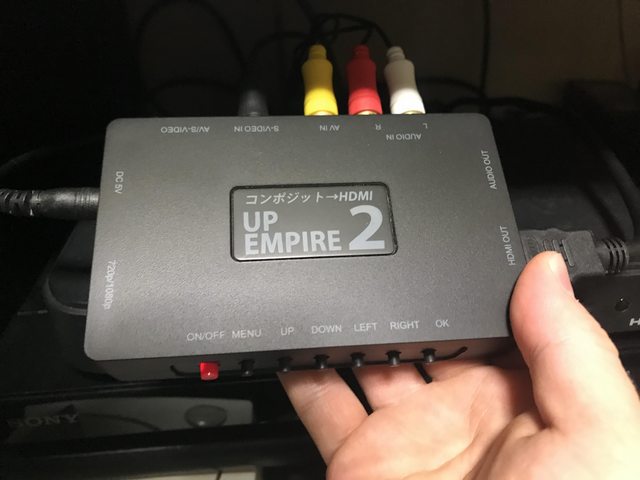
Like vinyl records, Laserdiscs have an advantage with nice large artwork and some excellent deluxe edition releases. I was able to pick up a number of “The Art of Akira Kurosawa” special edition Laserdiscs released by Toho in the 1990s, which all came in deluxe boxes, had the films transferred from HD masters, and included reproduction theatrical posters and lengthy booklets with written information on the films by film critics, filmmakers, cast and crew and others. The discs are all in the standard CLV format with many being double or even triple disc editions, with the printed chapter listings having detailed spoilers on each scene. Unfortunately there are no extras on the discs themselves, and Toho actually released a separate “Kurosawa Theatrical Trailers” Laserdisc as part of the collection as a mail-in promotional disc, rather than including them on the expensive individual films. These were quite pricey originally, with double disc films like “Ikiru” being ¥12,000 and triple disc films like “Red Beard” being ¥15,000. It’s crazy to think that I picked up these titles used at a bookstore for ¥500 each. Laserdiscs were quite expensive though interestingly back in the early days, they were actually cheaper than pre-recorded videotapes. The discs were cheaper and easier to manufacture, but with prices of tapes falling in the late 80s and early 90s for consumers, Laserdiscs didn't have a big dip in price point as the collector's market was seemingly the target.
So far I had only looked at CLV Laserdiscs - discs that were capable of holding 1 hour of video and audio per side. CAV, which only held 30 minutes per side but with higher quality would be next. While LD hunting at a second hand shop, I actually found two out of the three CAV discs of Disney’s “Fantasia”, but they were not in the best of shape. But looking behind the bins of dusty discs, a nearly pristine looking massive Japanese Laserdisc box of “Fantasia” was sitting on the shelf hidden away. It had all the discs inside, all the collectibles including the envelope with the lithograph, but missing the outer obi which I could live without. ¥900 was an absolute steal. I have “Fantasia” on DVD and Blu-ray and was hoping this would be the uncensored version, but alas, this also has optical censorship to remove the problematic centaur characters as well. Though it is not the same transfer, as the Laserdisc edition presents the 50th anniversary restoration, which at 119 minutes is about five minutes shorter than the later DVD and Blu-ray releases which restore additional orchestral sequences. The narration by Deems Taylor is fully intact on the Laserdisc which had to be re-recorded by actor Corey Burton for the newer restoration. In addition, the Laserdisc box includes the US theatrical trailer and the “Fantasia: Making of a Masterpiece” documentary which was also included with the 1991 double VHS release, and was not ported to the later DVD or Blu-ray editions. Featuring numerous interviews with animators, Roy Disney, as well as critics including Leonard Maltin and hosted by actor Michael Tucker, one slightly unfortunate part of this Japanese edition is that the documentary is partially dubbed, with Tucker’s narration segments being in Japanese while all the interviews and film clips are in English with burned-in Japanese subtitles.
“X - The Movie” (1996) was another CAV pickup, and another animated feature. The Rintaro directed feature based on the manga by CLAMP received mixed reactions for its convoluted story and not particularly catering to either the fanbase or newcomers, though the animation itself was outstanding as expected. The 98 minute film is presented in the theatrical 1.85:1 aspect ratio and spread across two CAV discs on four sides. With CAV, it is interesting to see that the minutes/seconds counter on the player’s display changing to a frame number, so jumping to an exact frame can be done by entering the specific number on the remote. The frame by frame is incredibly smooth and something that CLV discs couldn’t do without jittering. Though without the timer, it’s hard to know how much time you have left with the feature. It’s also a bit troublesome to have to flip or switch the disc more times than usual. As for the boxset itself, it is a stellar looking deluxe box as well, with the two discs having their own sleeves, a deluxe book of artwork and interviews plus exclusive artwork included. Unfortunately there were no digital extras on this release, without any interviews or trailers that were found on later DVD and Blu-ray releases. A very satisfying buy for ¥500.
So how different is CAV compared to CLV in picture quality? With “Fantasia” it was in the 1.33:1 aspect ratio and with “X” it was in the 1.85:1 aspect ratio for which I zoomed in to fill the screen for the viewing. While the image was sharper, it’s hard to say exactly as I didn’t have an exact CLV comparison for either. Obviously the DVD and Blu-ray of “Fantasia” which were made from newer longer restorations are miles ahead in comparison, the Laserdisc version looked quite good. “X” had nice animated effects with bright flashes and detail in the action sequences, but it also all depends on the source material, the age of the transfer as well. “Fantasia” was a disc from 1991 and “X” was a disc from 1998. Just like DVDs and Blu-rays, there are noticeable improvements in encoding in newer discs compared to the oldest titles.
One thing that has sparked since getting a Laserdisc player is the excitement to find used Laserdiscs. For years, I’ve known where to buy books, vinyl, Blu-rays, and video games locally and the good places to hunt for them. I’ve seen Laserdiscs sporadically at random book stores and record stores, but they would come and go quickly, usually in bargain junk bins as collecting for the format has become basically dead in the country. In the last few weeks I headed to second hand electronics stores, pawn shops, book stores and more and was able to find a number of places that had some Laserdiscs priced from 10 yen to 100 yen, with a few that were a bit higher in collectible value. It was hit or miss, with many stores having no Laserdiscs at all, some having bins filled with dusty discs and others having only a handful. I so far have not come across a disc plagued with disc rot, thankfully. Most have been in excellent condition with the discs themselves and the covers, though there have been a number of beat up copies as well. I’ve even come across a number of sealed discs which were a treat to open. Hunting for Laserdiscs has been incredibly fun, going to places all around Tokyo and in the surrounding areas that I had never been to, and there are a few more areas that I’d like to go to in the near future for more digging. There are of course ways to find specific discs online from merchants and auctions, but this is like a new form of crate digging that has reinvigorated my collector’s senses, by physically getting dusty fingers and being able to handle them before a blind purchase. I had 40 LDs before acquiring a Laserdisc player. Two weeks later, my collection is now close to 100 LDs. As it's been a dead format for more than twenty years and from what I've seen, second hand stores that stock them are dumping their inventory as junk, it's now a good time as ever to look for discs even with a small budget. Though from what I've found online, there are a number of late period LDs and collectible titles that will rack up a hefty price in auctions. Happy hunting!
But will the Laserdisc find a retro style comeback like vinyl records or 8-bit game cartridges? It’s highly doubtful that will happen, as it was never a major market to begin with and the nostalgia lies only with the people who were collectors in the first place. For vinyl, as old as the format is can sound as good if not better than a digital counterpart. For 8-bit games, the simplified retro look, sound, and gameplay are still easily accessible to modern gamers and non-gamers, so playing them on old hardware or in emulated form is common. But for people to watch a movie in standard definition video in which the film stops halfway through and use discs that are thick and heavy? Most likely not.
When DVDs were introduced in 1996, it basically solved everything that was cumbersome about LDs. Discs became smaller. Digital data could be stored. Discs could be dual layered and didn’t have to be flippers, containing all information readable from one side. Multiple audio and subtitle tracks could be included. Disc menus made accessibility easier. The cost was much cheaper. Plus the fact that DVDs were used for data storage for computers as well as video game consoles such as the PlayStation 2, the quick widespread adoption and the consumers being ready for a new compact format was a perfect storm to kill off the Laserdisc. There were a few late titles that overlapped with DVDs for a short time, but there have been no new Laserdisc releases in the last two decades and probably never will be. That’s understandable and absolutely fine. While this old technology may not have been part of my youth, it’s certainly found a place in my home theater now as a massive and charming format.
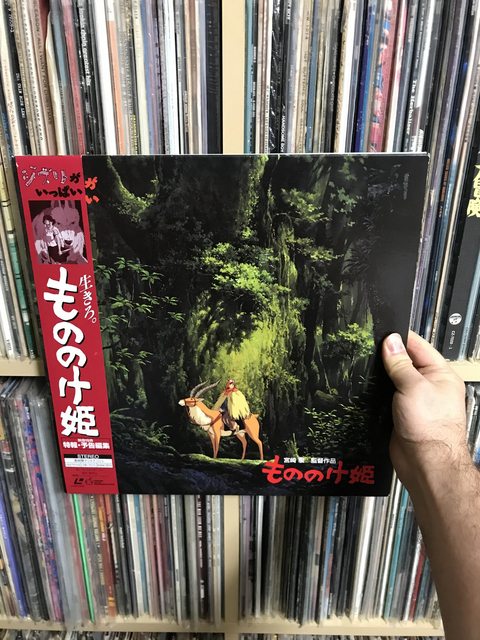
We at Rewind DVDCompare are NOT going to start adding Laserdiscs to our database, as the Laserdisc Database have done an excellent job with their site and their collection database. There are also helpful groups such as Laserdisc Forever! And Laserdisc Collectors Club on Facebook, various movie forums, and YouTubers such as Techmoan and Technology Connections as well as individual shoppers and unboxers with their hauls that have proved to be entertaining and informative for me and for others that have an interest. Below are some informative videos on the format for further interest:
Techmoan's first time buying a Laserdisc player in 2015
"Laserdisc Audio Guide – Part 1: An LD Audio Overview" by Culturedog
(See also "Part 2: Dolby Surround & Pro-Logic Decoding", "Part 3: AC-3 Dolby Digital", "Part 4: DTS" and "Part 5: Wrap Up - Cables, THX, DD EX, MUSE and More")
"Laserdisc: An Introduction" by Technology Connections
(See also "Laserdisc: Features, Follies, & Evolution", "Laserdisc's Failure: What Went Wrong", "DVD: The Death Knell of Laserdisc" and "MUSE Hi-Vision Laserdisc: The Blu-ray of 1994")
A vintage featurette produced by Pioneer on how Laserdiscs are manufactured (in English)
A vintage Pioneer promo on Laserdiscs, players, and manufacturing (in Japanese)
An early Laserdisc promo by Magnavox starring Leonard Nimoy
Vintage clips from "Entertainment Tonight" with Leonard Maltin introducing some special edition Laserdiscs.

